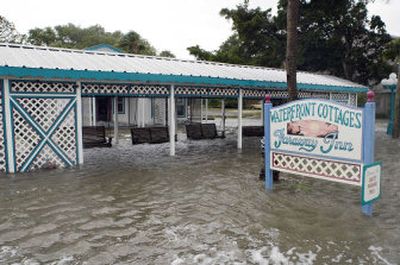Alberto gives officials a not-so-dry run

CRYSTAL RIVER, Fla. – The first tropical storm of the Atlantic hurricane season gave emergency planners a chance to run through their disaster plans – and gave storm-weary Gulf Coast residents a bit of a break.
Early predictions that tropical storm Alberto would strengthen into a hurricane didn’t pan out. But officials said the weaker-than-forecasted storm still gave them real-world practice on the lessons learned from the slow response to some of last year’s storms.
“It was a nice tune-up, a nice warm-up,” said hurricane specialist Richard Pasch.
Residents were forced to sandbag homes and businesses as waters rose thigh-high in some neighborhoods. But many people seemed to accept flooding of that sort as part of coastal life – and sighed with relief that it wasn’t worse.
“We probably got about 2 inches in the house,” said Scott Faulkenberg, 39, the owner of a scuba diving shop in Crystal River. He said it was the fourth time in six years his home had flooded, but he had no plans to move.
“We need a new carpet anyway,” he said.
The storm’s center came ashore around noon near Adams Beach, about 50 miles southeast of Tallahassee. Its winds were 40 mph, down from 65 mph in the morning and well below the 74 mph hurricane threshold that forecasters thought it might cross.
The prospect of a hurricane hitting the state less than two weeks into the season threw a brief scare into Florida, and more than 20,000 were ordered to evacuate as Alberto closed in.
If Alberto had struck as a hurricane, it would have been an alarming start to the season, which began June 1. No hurricane has hit the United States this early in the hurricane season in 40 years.
Tampa and other areas had gotten 4 to 6 inches of rain by daybreak Tuesday, and forecasters said total rainfall could reach 10 inches in central Florida and southeastern Georgia over the next few days.
In Crystal River, two manatees explored what had been the front lawn of David Garrick’s apartment building, relieving the tension of a long afternoon after Garrick tried unsuccessfully to keep water out of the complex.
Forecasters said the northeastern coast of Florida and the coasts of Georgia and the Carolinas would be vulnerable to tornadoes for up to several days until Alberto cleared the area.
But National Hurricane Center Director Max Mayfield said that overall, Alberto “shouldn’t be life-threatening by any means, as long as people are careful, and especially surfers.”
The only road in and out of Cedar Key for the island’s 940 residents was briefly closed because of flooding. But Cedar Key City Commissioner Pat O’Neal said, “We dodged a bullet.”
A total of about 21,000 homes and businesses lost power during the storm. All but 4,300 customers had electricity restored by early evening.
It was unclear how many of those ordered to evacuate their homes actually left.
Levy County sheriff’s Capt. Chuck Bastak said residents of Cedar Key in the gulf were “gun shy” about evacuating after a no-name storm of 1993 beat up the island and authorities were slow to let them return to their homes.
“They’re kind of hard-core,” Bastak said of some longtime island residents. “It would take an act of Congress, God and weather to get them out of there.”
In assessing their disaster plans, hurricane specialists said they ran into a few computer glitches but nothing that couldn’t be fixed by the next storm.
“You can train all you want, but nothing beats the real deal,” said state Emergency Management spokesman Mike Stone.
Alberto’s rainfall should also help the state battle wildfires that have blazed in different areas over the past two months, Agriculture Commissioner Charles Bronson said. Eighteen brush fires were extinguished by Tuesday’s rain, but about 150 were still active, Bronson said.